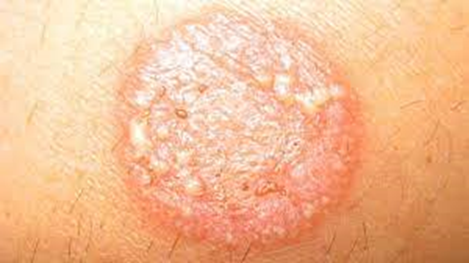A nurse is reinforcing teaching about the care of a client who has tinea corporis with a newly licensed nurse. Which of the following should the nurse include in the teaching?
Place on airborne precautions.
Avoid direct contact.
Isolate for 24 hr. after lesions appear.
Administer a broad-spectrum antibiotic.
The Correct Answer is B
Choice A Reason:
Place on airborne precautions. This is incorrect. Tinea corporis isn't transmitted through the air. Airborne precautions are specific infection control measures for diseases transmitted through airborne particles, like tuberculosis or measles, which are caused by specific bacteria or viruses.
Choice B Reason:
Avoid direct contact is correct. Direct contact is a crucial precaution to prevent the spread of tinea corporis. It's a contagious infection, often transmitted through skin-to-skin contact or by sharing contaminated items such as clothing, towels, or bedding. Encouraging precautions like not sharing personal items and avoiding direct skin contact helps prevent the spread of the infection to others.
Choice C Reason:
Isolate for 24 hr. after lesions appear is incorrect. While it's essential to take precautions to prevent spread, isolating for only 24 hours after lesions appear might not be sufficient. The infection can remain contagious until it's effectively treated and lesions have resolved. More extended isolation or precautions might be necessary until the infection is no longer transmissible.
Choice D Reason:
Administer a broad-spectrum antibiotic is incorrect. Tinea corporis is a fungal infection, not a bacterial one, so antibiotics would not be effective against it. Antifungal medications, such as topical or oral antifungals, are the primary treatment for tinea corporis. Using an antibiotic would not treat the fungal infection and might lead to inappropriate medication use.

Nursing Test Bank
Naxlex Comprehensive Predictor Exams
Related Questions
Correct Answer is C
Explanation
Choice A Reason:
Nerve damage is incorrect. Nerve damage typically presents with symptoms such as altered sensation, numbness, tingling, or shooting pain along the path of the nerve. The symptoms described in the scenario are more indicative of localized inflammation rather than nerve-related issues.
Choice B Reason:
Infection is incorrect. Infection at the insertion site can manifest with redness, warmth, tenderness, and possibly purulent drainage. While infection is a potential complication of IV therapy, the symptoms described might indicate a different issue.
Choice C Reason:
Infiltration is correct. Infiltration occurs when the IV fluid leaks into the surrounding tissues. Symptoms often include swelling, coolness, and tenderness at the site due to the fluid accumulating in the tissue instead of going into the vein. These symptoms align with the description provided.
Choice D Reason:
Phlebitis is incorrect. Phlebitis is the inflammation of a vein, typically presenting with redness, warmth, and tenderness along the vein's path.
Correct Answer is B
Explanation
Choice A Reason:
"Will use ibuprofen when I have a headache." This statement is inappropriate. Enoxaparin is an anticoagulant, and using nonsteroidal anti-inflammatory drugs (NSAIDs) like ibuprofen can increase the risk of bleeding. So, using ibuprofen isn't recommended without consulting a healthcare professional while on enoxaparin.
Choice B Reason:
“Will use an electric razor for shaving.” This statement is correct. Enoxaparin is an anticoagulant, and using a sharp razor increases the risk of bleeding. Using an electric razor reduces the chance of nicks or cuts that could lead to bleeding complications while on this medication.
Choice C Reason:
“Will avoid the use of stool softeners." This statement is inappropriate. Enoxaparin doesn't directly interact with stool softeners. However, it's crucial to consult a healthcare provider before taking any new medications, including stool softeners, while on enoxaparin, as there might be potential interactions or effects on clotting.
Choice D Reason:
"I will massage the site after each injection." This statement is inappropriate. Massaging the site after an enoxaparin injection could potentially cause bruising or irritation. The usual recommendation is to apply gentle pressure at the injection site for a short time after the injection but not to massage it vigorously.
Whether you are a student looking to ace your exams or a practicing nurse seeking to enhance your expertise , our nursing education contents will empower you with the confidence and competence to make a difference in the lives of patients and become a respected leader in the healthcare field.
Visit Naxlex, invest in your future and unlock endless possibilities with our unparalleled nursing education contents today
Report Wrong Answer on the Current Question
Do you disagree with the answer? If yes, what is your expected answer? Explain.
Kindly be descriptive with the issue you are facing.
